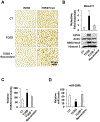Regulation of a long noncoding RNA MALAT1 by aryl hydrocarbon receptor in pancreatic cancer cells and tissues
- PMID: 32900487
- PMCID: PMC7572814
- DOI: 10.1016/j.bbrc.2020.08.053
Regulation of a long noncoding RNA MALAT1 by aryl hydrocarbon receptor in pancreatic cancer cells and tissues
Abstract
Environmental toxicants such as dioxins and polycyclic aromatic carbons are risk factors for pancreatitis and pancreatic cancer. These toxicants activate aryl hydrocarbon receptor (AHR), a ligand-activated transcription factor, of which activation regulates many downstream biological events, including xenobiotic metabolism, inflammation, and cancer cell growth and transformation. Here, we identified that environmental toxicant-activated AHR increased expression of metastasis associated lung adenocarcinoma transcript 1 (MALAT1) in pancreatic cancer cells and pancreatic tissues. The MALAT1 is a long noncoding (lnc) RNA which interacts with Enhancer of Zeste 2 (EZH2), a histone methyltransferase with epigenetic silencer activity, and the MALAT1-EZH2 interaction increased its epigenetic silencing activity. In contrast, AHR antagonist, CH223191 or resveratrol, counteracted the AHR-mediated MALAT1 induction and MALAT1-enahnced EZH2 activity. Collectively, these results revealed a novel pathway of how environmental exposure leads to epigenetic alteration via activation of AHR-MALAT1-EZH2 signaling axis under pancreatic tissue- and cancer cell-context.
Keywords: Aryl hydrocarbon receptor; EZH2; Environmental toxicants; Epigenetic regulation; MALAT1; Pancreas.
Copyright © 2020 Elsevier Inc. All rights reserved.
Conflict of interest statement
Conflict of interest
All the authors declare no conflict of interest.
Figures




Similar articles
-
LncRNA MALAT1 promotes epithelial-to-mesenchymal transition of esophageal cancer through Ezh2-Notch1 signaling pathway.Anticancer Drugs. 2018 Sep;29(8):767-773. doi: 10.1097/CAD.0000000000000645. Anticancer Drugs. 2018. PMID: 29916899
-
Context-Dependent Epigenetic Regulation of Nuclear Factor of Activated T Cells 1 in Pancreatic Plasticity.Gastroenterology. 2017 May;152(6):1507-1520.e15. doi: 10.1053/j.gastro.2017.01.043. Epub 2017 Feb 8. Gastroenterology. 2017. PMID: 28188746
-
Posttranscriptional silencing of the lncRNA MALAT1 by miR-217 inhibits the epithelial-mesenchymal transition via enhancer of zeste homolog 2 in the malignant transformation of HBE cells induced by cigarette smoke extract.Toxicol Appl Pharmacol. 2015 Dec 1;289(2):276-85. doi: 10.1016/j.taap.2015.09.016. Epub 2015 Sep 28. Toxicol Appl Pharmacol. 2015. PMID: 26415832
-
The aryl hydrocarbon receptor cross-talks with multiple signal transduction pathways.Biochem Pharmacol. 2009 Feb 15;77(4):713-22. doi: 10.1016/j.bcp.2008.08.031. Epub 2008 Sep 5. Biochem Pharmacol. 2009. PMID: 18817753 Free PMC article. Review.
-
Mechanisms of ligand-induced aryl hydrocarbon receptor-mediated biochemical and toxic responses.Toxicol Pathol. 1998 Sep-Oct;26(5):657-71. doi: 10.1177/019262339802600510. Toxicol Pathol. 1998. PMID: 9789953 Review.
Cited by
-
The complexity of nicotinamide adenine dinucleotide (NAD), hypoxic, and aryl hydrocarbon receptor cell signaling in chronic kidney disease.J Transl Med. 2023 Oct 9;21(1):706. doi: 10.1186/s12967-023-04584-8. J Transl Med. 2023. PMID: 37814337 Free PMC article. Review.
-
Long noncoding RNA MALAT-1: A versatile regulator in cancer progression, metastasis, immunity, and therapeutic resistance.Noncoding RNA Res. 2024 Feb 1;9(2):388-406. doi: 10.1016/j.ncrna.2024.01.015. eCollection 2024 Jun. Noncoding RNA Res. 2024. PMID: 38511067 Free PMC article. Review.
-
Nonalcoholic Fatty Liver Hepatocyte-Derived lncRNA MALAT1 Aggravates Pancreatic Cell Inflammation via the Inhibition of Autophagy by Upregulating YAP.Comput Intell Neurosci. 2022 Aug 31;2022:2930960. doi: 10.1155/2022/2930960. eCollection 2022. Comput Intell Neurosci. 2022. Retraction in: Comput Intell Neurosci. 2023 Jul 26;2023:9831369. doi: 10.1155/2023/9831369. PMID: 36093484 Free PMC article. Retracted.
-
Identification of PBMC-based molecular signature associational with COVID-19 disease severity.Heliyon. 2021 May;7(5):e06866. doi: 10.1016/j.heliyon.2021.e06866. Epub 2021 Apr 20. Heliyon. 2021. PMID: 33898797 Free PMC article.
-
Role of Ubiquitination and Epigenetics in the Regulation of AhR Signaling in Carcinogenesis and Metastasis: "Albatross around the Neck" or "Blessing in Disguise".Cells. 2023 Sep 29;12(19):2382. doi: 10.3390/cells12192382. Cells. 2023. PMID: 37830596 Free PMC article. Review.
References
-
- Lowenfels AB, Maisonneuve P, Cavallini G, et al. Pancreatitis and the risk of pancreatic cancer. International Pancreatitis Study Group. N Engl J Med. 328 (1993) 1433–1437, https://www.nejm.org/doi/full/10.1056/nejm199305203282001. - DOI - PubMed
-
- Yuan C, Morales-Oyarvide V, Babic A, Clish CB, Kraft P, Bao Y, Qian ZR, Rubinson DA, Ng K, Giovannucci EL, Ogino S, Stampfer MJ, Gaziano JM, Sesso HD, Cochrane BB, Manson JE, Fuchs CS, Wolpin BM. Cigarette Smoking and Pancreatic Cancer Survival. J Clin Oncol. 35 (2017) 1822–1828, https://ascopubs.org/doi/10.1200/JCO.2016.71.2026. - DOI - PMC - PubMed
-
- Muto H, Takizawa Y. Dioxins in cigarette smoke. Arch Environ Health. 44 (1989) 171–174, https://www.tandfonline.com/doi/abs/10.1080/00039896.1989.9935882. - DOI - PubMed
-
- Stedman RL. The chemical composition of tobacco and tobacco smoke. Chem Rev. 68 (1968) 153–207, https://pubs.acs.org/doi/abs/10.1021/cr60252a002. - DOI - PubMed
Publication types
MeSH terms
Substances
Grants and funding
LinkOut - more resources
Full Text Sources
Medical

